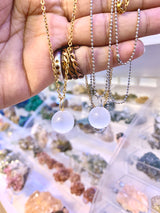5D Healing Crystals
Selenite pendant
Selenite crystals, also known as Gypsum Fibrosum or Shi Gao in Pinyin, is not only a plaster building material, but also one of commonly used Chinese herbs. Just like Da Huang (rhubarb) and Fu Zi (aconite), it has long occupied an important position in traditional Chinese medicine thanks to its amazing healing properties for the treatment of #serious, #incurable, or #chronic #illness. Besides of the medical records from doctors, the medicinal uses of selenite can be found in many writers and poets’ essay. Here is one example. According to Yue Wei Cao Tang Bi Ji (Jottings from the Grass Hut for Examining Minutiae), written by a literary giant called Ji Yun (1724–1805), in 1793 a doctor from Tong Cheng used gypsum-based remedy saved countless lives from epidemic outbreak in the capital city. And here are some tips on how to use selenite effectively.
Selenite crystals benefits
As one of well-known healing stones, people in the west believe that it has the amazing power of cleansing energy blocks in other stones and crystals. More importantly, it can remove the accumulation of negative energy regardless of the physical and the etheric bodies.
Indeed, throughout TCM history there are many physicians who are skilled at using selenite. But apparently Zhang Xichun, one of great scholar-physicians in China, is the best of the best. He highly regards the medicinal properties of this herb and ever boldly reviewed that: “Gypsum is the No. 1 herb that really has the power to revive the dying. It works just like a charm in treatment of excess-heat type exogenous diseases.” In the sixth of volume 4 in his famous medical work of Yi Xue Zhong Zhong Can Xi Lu (Records of Heart-Felt Experiences in Medicine with Reference to the West), there are 23 medical cases and 38 herbal prescriptions recorded in the chapter of seasonal febrile diseases. Among them, as many as 27 prescriptions are based on gypsum. One of the outstanding examples is that he was accustomed to using it together with aspirin and reportedly this strange combination worked wonders in many tricky illnesses. So, in terms of the uses for gypsum rock according to syndrome differentiation, doctor Zhang Xichun has played a very important role.
In summary, it has two major health benefits – treating profusely sweating and extreme thirst. Since it is not the only herb that can treat these two-mentioned symptoms in traditional Chinese medicine, why you have to choose it? To make it clearer of how it works, comparing it with other similar herbs and then finding out their difference is obviously a viable shortcut.
As for the symptom of profusely sweating, rock gypsum plays a different role compared to Huang Qi (Astragalus Root) and Gui Zhi (Ramulus Cinnamomi). In comparison, gypsum is usually accompanied with a sense of polydipsia and hot body; astragalus is often accompanied by swelling and sallow complexion; ramulus cinnamomi is more accompanied with palpitations and abdominal pain. In addition, they can be also distinguished by the presence of pulse. Simply put, astragalus governs excessive perspiration with swelling; gypsum rules sweating and irritation; ramulus cinnamomi treats sweating and palpitation.
In terms of the symptom of extreme thirst, what gypsum treats is also different from what Bai Zhu (White Atractylodes), Ze Xie (Water Plantain), and Fu Ling (Poria) treat. The former refers to not only self-perception, but also drinking plenty of water, or even cold drinks; the latter means the thirst that is with no desire to drink, or drinking less, especially hot drinks. In addition, their tongue pictures are also different. The former is characterized as dry or scorched tongue coating while the latter features moist, thin white tongue coating and large fat tongue with scalloped edges.




